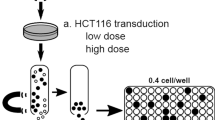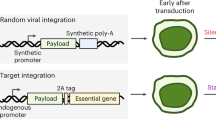Abstract
Lentiviral vectors offer unique versatility and robustness as vehicles for gene delivery. They can transduce a wide range of cell types and integrate into the host genome in both dividing and post-mitotic cells, resulting in long-term expression of the transgene both in vitro and in vivo. This protocol describes how lentiviral vectors can be produced, purified and titrated. High titer suspensions can be routinely prepared with relative ease: a low-titer (106 viral particles/ml) unpurified preparation can be obtained 3 d after transfecting cells with lentiviral vector and packaging plasmids; a high-titer (109 viral particles/ml) purified preparation requires 2 more days.
This is a preview of subscription content, access via your institution
Access options
Subscribe to this journal
Receive 12 print issues and online access
$259.00 per year
only $21.58 per issue
Buy this article
- Purchase on SpringerLink
- Instant access to full article PDF
Prices may be subject to local taxes which are calculated during checkout

Similar content being viewed by others
References
Tiscornia, G., Singer, O. & Verma, I.M. Design and cloning of lentiviral vectors expressing small interfering RNAs. Nat. Protocols (2006) doi 10.1038/nprot.2006.36.
Trono, D. Lentiviral Vectors (Berlin-Heidelberg, Springer-Verlag, 2002).
Delenda, C. Lentiviral vectors: optimization of packaging, transduction and gene expression. J. Gene Med. 6, S125–S138 (2004).
Dull, T. et al. A third-generation lentivirus vector with a conditional packaging system. J. Virol. 72, 8463–8471 (1998).
Naldini, L. et al. In vivo gene delivery and stable transduction of nondividing cells by a lentiviral vector. Science 272, 263–267 (1996).
Brenner, S. & Malech, H.L. Current developments in the design of onco-retrovirus and lentivirus vector systems for hematopoietic cell gene therapy. Biochim. Biophys. Acta 1640, 1–24 (2003).
Rubinson, D.A. et al. A lentivirus-based system to functionally silence genes in primary mammalian cells, stem cells and transgenic mice by RNA interference. Nat. Genet. 33, 401–406 (2003).
Tiscornia, G., Singer, O., Ikawa, M. & Verma, I.M. A general method for gene knockdown in mice by using lentiviral vectors expressing small interfering RNA. Proc. Natl. Acad. Sci. USA 100, 1844–1848 (2003).
Miyoshi, H., Blomer, U., Takahashi, M., Gage, F.H. & Verma, I.M. Development of a self-inactivating lentivirus vector. J. Virol. 72, 8150–8157 (1998).
Zufferey, R. et al. Self-inactivating lentivirus vector for safe and efficient in vivo gene delivery. J. Virol. 72, 9873–9880 (1998).
Stevenson, M. Molecular biology of lentivirus-mediated gene transfer. Curr. Top. Microbiol. Immunol. 261, 1–30 (2002).
Cronin, J., Zhang, X.Y. & Reiser, J. Altering the tropism of lentiviral vectors through pseudotyping. Curr. Gene Ther. 5, 387–398 (2005).
Sandrin, V., Russell, S.J. & Cosset, F.L. Targeting retroviral and lentiviral vectors. Curr. Top. Microbiol. Immunol. 281, 137–178 (2003).
Zufferey, R. Production of lentiviral vectors. Curr. Top. Microbiol. Immunol. 261, 107–121 (2002).
Sinn, P.L., Sauter, S.L. & McCray, P.B. Gene therapy progress and prospects: development of improved lentiviral and retroviral vectors—design, biosafety, and production. Gene Ther. 12, 1089–1098 (2005).
Saenz, D.T. & Poeschla, E.M. FIV: from lentivirus to lentivector. J. Gene Med. 6, S95–S104 (2004).
Logan, A.C., Haas, D.L., Kafri, T. & Kohn, D.B. Integrated self-inactivating lentiviral vectors produce full-length genomic transcripts competent for encapsidation and integration. J. Virol. 78, 8421–8436 (2004).
Pfeifer, A., Ikawa, M., Dayn, Y. & Verma, I.M. Transgenesis by lentiviral vectors: lack of gene silencing in mammalian embryonic stem cells and preimplantation embryos. Proc. Natl. Acad. Sci. USA 99, 2140–2145 (2002).
Lois, C., Hong, E.J., Pease, S., Brown, E.J. & Baltimore, D. Germline transmission and tissue-specific expression of transgenes delivered by lentiviral vectors. Science 295, 868–872 (2002).
Verhoeyen, E. & Cosset, F.L. Surface-engineering of lentiviral vectors. J. Gene Med. 6, S83–S94 (2004).
Author information
Authors and Affiliations
Corresponding author
Ethics declarations
Competing interests
The authors declare no competing financial interests.
Rights and permissions
About this article
Cite this article
Tiscornia, G., Singer, O. & Verma, I. Production and purification of lentiviral vectors. Nat Protoc 1, 241–245 (2006). https://doi.org/10.1038/nprot.2006.37
Published:
Issue Date:
DOI: https://doi.org/10.1038/nprot.2006.37
This article is cited by
-
Temporal coordination of the transcription factor response to H2O2 stress
Nature Communications (2024)
-
Neuroprotective Therapeutic Potential of microRNA-149-5p against Murine Ischemic Stroke
Molecular Neurobiology (2024)
-
Positron emission tomography imaging of the sodium iodide symporter senses real-time energy stress in vivo
Cancer & Metabolism (2023)
-
A click chemistry-mediated all-peptide cell printing hydrogel platform for diabetic wound healing
Nature Communications (2023)
-
Distinct and targetable role of calcium-sensing receptor in leukaemia
Nature Communications (2023)



